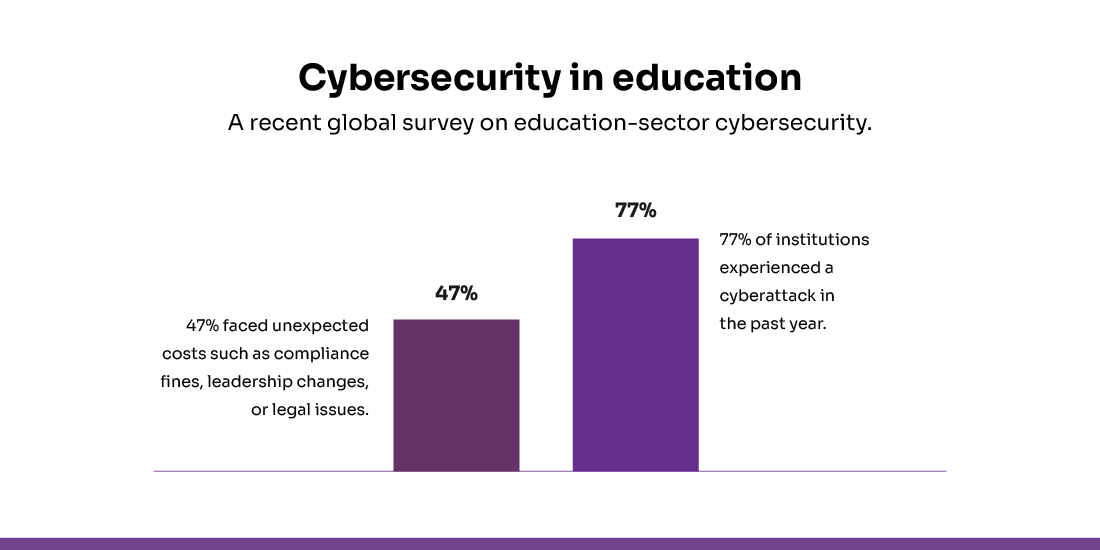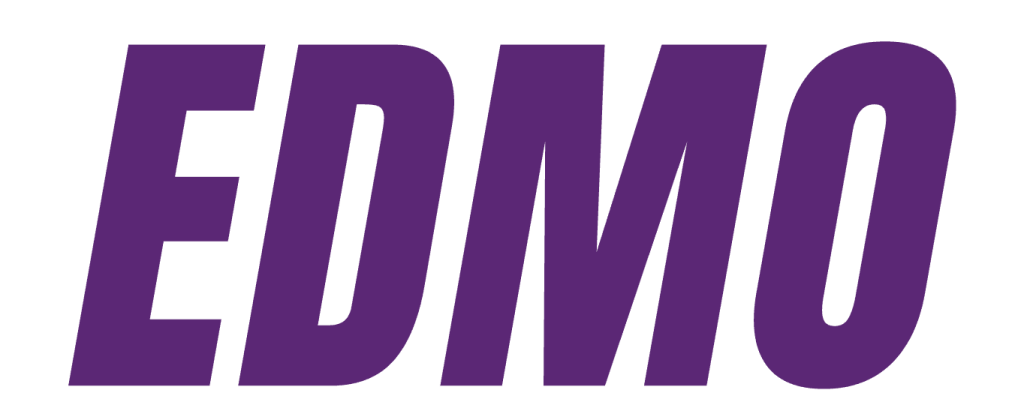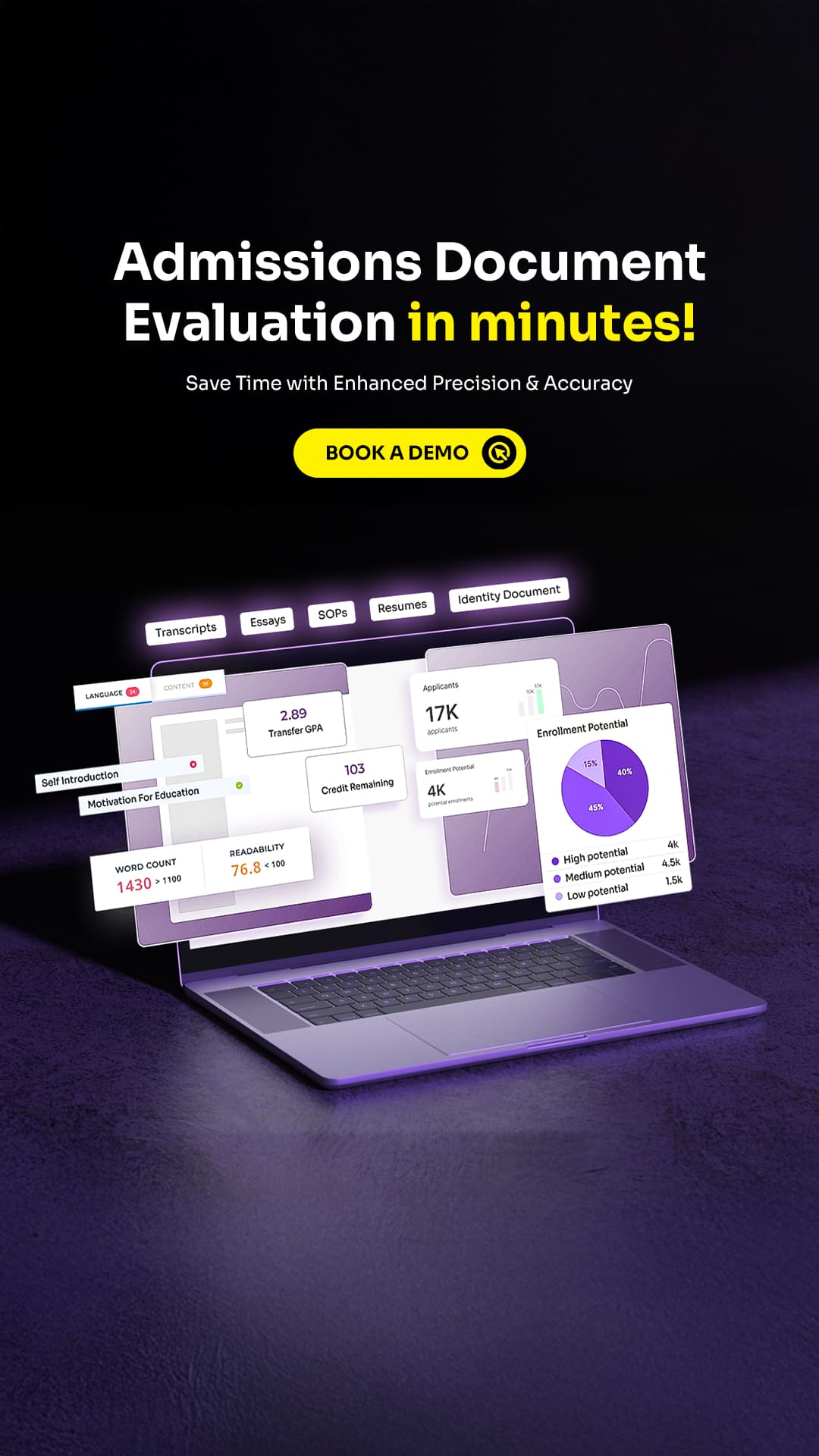Table Of Contents
- 1Introduction
- 2Risk Management in Higher Education: A Comprehensive Overview
- 3Understanding Risks and Risk Drivers
- 4The Evolving Risk Environment in Higher Education Institutions
- 5Building a Robust Risk Management Framework in Higher Education
- 6Effective Strategies for Risk Management in Higher Education
- 7Conclusion
Introduction
In today’s rapidly changing education environment, managing risks is more important than ever. A 2024 survey found that 71% of higher-education leaders view declining enrollment as a major risk, up from 67% the previous year. This highlights the growing challenges institutions face, including enrollment fluctuations, financial pressures, cybersecurity threats, and operational disruptions.
Effective Risk Management in Higher Education enables institutions to identify these risks early, implement strategies to minimize their impact, and plan for long-term stability and growth. By proactively addressing potential threats, universities can safeguard their operations, maintain academic quality, and strengthen their reputation in an increasingly competitive environment.
Risk Management in Higher Education: A Comprehensive Overview
Effective risk management in higher education means systematically identifying, assessing, and mitigating risks that could impact an institution’s academic programs, operations, and long-term sustainability. Universities face risks across multiple areas, including regulatory compliance, financial stability, cybersecurity, campus safety, research integrity, and technological infrastructure.
By taking a proactive and holistic approach, institutions can not only prevent or minimize potential disruptions but also enhance decision-making, protect their reputation, and ensure a safe and supportive environment for students, faculty, and staff. Strong risk management helps universities stay resilient, adapt to changing conditions, and maintain their mission of providing high-quality education.
Understanding Risks and Risk Drivers
The term “risk” is often defined in various ways across institutions, which can lead to confusion. For clarity, we use the following definitions to establish a consistent perspective:
- Risk refers to a state of uncertainty where the outcome can be answered with a clear “yes” or “no.” Some of these outcomes may be undesirable.
- Risk drivers are factors that influence the likelihood or impact of a risk. They may take two forms:
- Continuous factors (trends): Ongoing elements that increase or decrease a risk’s probability or effect.
- Interrelated risks: One risk that directly influences the occurrence or impact of another.
It’s important to note that while all risks can act as risk drivers, not all risk drivers are actual risks. This overlap can make distinguishing between the two challenging.
Risks may also have both primary and secondary layers. A primary risk may be driven by direct risk drivers, while a secondary risk may have its own set of influencing factors.
Understanding this distinction is critical for Enterprise Risk Management (ERM) programs, as consistent definitions help leadership prioritize resources effectively. By analyzing risks and their drivers, institutions can allocate resources more strategically to mitigate overall exposure.
The following are key risks likely to impact colleges and universities over the next 1–3 years:
Cybersecurity Breaches
With higher-education institutions relying more heavily on digital systems, the risk of data breaches and cyber-attacks is rising. A recent UK survey found that 97% of universities experienced a cyber-attack or security breach in the past year, with 43% facing attacks at least once a week, highlighting the growing threat to institutional data and operations.
Risk drivers:
- Weak or outdated security practices
- Separate IT systems for academic and administrative functions
- Lack of training and awareness
- Insider threats
- Vulnerable legacy systems
- Third-party vulnerabilities
- Phishing and scams
Mitigation strategies:
- Enforce strong passwords and multi-factor authentication
- Train employees on cybersecurity best practices
- Encrypt sensitive data
- Keep software updated
- Develop disaster recovery, incident response, and backup plans
Faculty and Staff Attrition
High turnover among faculty and staff poses a significant challenge for higher education institutions, resulting in the loss of valuable institutional knowledge, increased recruitment and training costs, and lower morale among remaining employees. A survey found that 16% of full‑time higher‑ed employees are at risk of leaving their institution within the next two years.
Risk drivers:
- Limited remote work options
- Lack of promotion opportunities
- Uncompetitive pay and benefits
Mitigation strategies:
- Promote work/life balance through flexible arrangements
- Offer competitive compensation and benefits
- Provide clear pathways for professional growth
- Foster a supportive and inclusive workplace culture
Student Activism
Student-led protests can disrupt operations and affect reputation. The spring of 2024 saw a surge in activism, including tent encampments and demonstrations tied to political and social issues.
Risk drivers:
- Poor communication with stakeholders
- Unclear enforcement of campus policies
- Campus culture and mission misalignment
Mitigation strategies:
- Navigate free speech carefully, upholding First Amendment rights
- Protect institutional reputation while balancing stakeholder interests
- Build trust through proactive communication and stakeholder engagement
Natural Disasters
Events like floods, wildfires, hurricanes, and earthquakes threaten campus infrastructure, student safety, and financial stability. Severe storms have caused the largest number of billion-dollar climate disasters in the past decade.
Risk drivers:
- Vulnerable geographic locations
- Inadequate campus and local infrastructure
- Deferred maintenance of facilities
Mitigation strategies:
- Use resources like Ready.gov and FEMA guidance
- Conduct financial impact assessments and scenario planning
- Communicate clearly with all stakeholders
- Support local communities where feasible
Student-Athlete Classification
Universities must carefully manage the classification of student-athletes, considering eligibility rules, scholarships, and program requirements. Clear policies and monitoring help prevent compliance issues and ensure fair treatment for all student-athletes.
Risk drivers:
- Changes in NCAA rules and federal labor laws
- Media attention and stakeholder expectations
Mitigation Strategies:
- Clarify legal impacts with expert counsel
- Update HR policies to reflect employee status
- Develop onboarding and training programs for athletes and staff
Evolving ED Regulations
Recent Supreme Court decisions, such as overturning Chevron deference and limiting race-based admissions, are reshaping federal oversight of colleges and universities. Institutions need to stay informed and adapt quickly to comply with Title IV and other federal education regulations to avoid penalties and ensure continued funding.
Mitigation strategies:
- Obtain legal guidance on compliance
- Monitor regulations and maintain compliance programs
- Conduct regular training and maintain proactive communication
Demographic Decline and Enrollment Challenges
Colleges and universities are seeing enrollment pressures as the number of traditional college‑age students declines. Economic and social changes are also affecting attendance. According to the National Student Clearinghouse Research Center, first‑year enrollments at U.S. four-year colleges dropped over 6% from fall 2023 to fall 2024.
Risk drivers:
- Decreasing student-age population
- Economic and social changes affecting college attendance
Mitigation strategies:
- Increase international student recruitment
- Expand study-abroad programs
- Engage adult learners and nontraditional students
Tuition Dependency
Approximately 25% of colleges and universities depend on tuition for over 60% of their revenue, leaving them financially vulnerable to fluctuations in enrollment, reduced donations, or other funding challenges. Effective financial planning and diversification of revenue streams are essential to reduce this risk and ensure long-term stability.
Mitigation strategies:
- Increase fundraising and grant acquisition
- Consider tuition resets
- Reduce expenses and maximize asset utilization
Declining Student Mental Health
A growing number of college students are facing significant mental health challenges. Surveys show that about half of students rate their mental health as “fair” to “poor,” and nearly 40% have considered dropping out or transferring because of these issues. This highlights the urgent need for universities to provide strong mental health support and resources on campus.

Mitigation strategies:
- Expand counseling and peer support programs
- Raise mental health awareness
- Train faculty to recognize warning signs
- Implement early-detection systems and wellness initiatives
Evolving Demand for Programs
Student interests are shifting, affecting the relevance of academic programs. STEM, business, and career-focused courses are seeing higher demand, while traditional humanities programs are experiencing declines.
Mitigation strategies:
- Analyze labor market trends
- Offer interdisciplinary and microcredential programs
- Invest in faculty development
- Partner with other institutions and industries
Lack of Institutional Agility
A lack of agility can hinder a university’s ability to respond to changes effectively, impacting finances, leadership decisions, and donor confidence. Institutions that are slow to adapt may struggle with emerging challenges and miss opportunities for growth.
Mitigation Strategies:
- Implement agile budgeting
- Enhance change management skills
- Conduct frequent leadership assessments
- Identify disruptive forces like AI and demographic shifts
Deferred Maintenance
U.S. colleges are projected to face $950 billion in deferred maintenance over the next decade, creating risks to campus safety, operational efficiency, and financial stability. Neglecting infrastructure can also increase vulnerability to cyber threats and other operational disruptions.
Mitigation Strategies:
- Conduct asset inventory and prioritize investments
- Develop maintenance and succession plans
- Reduce physical footprint and optimize resources
- Leverage technology for proactive facility management
Higher education institutions face a wide range of risks, from cybersecurity threats and financial pressures to declining student mental health and infrastructure challenges. Effectively identifying, assessing, and mitigating these risks is essential to protect students, staff, and institutional operations. By implementing proactive strategies—such as robust cybersecurity measures, financial planning, mental health support, crisis preparedness, and regular maintenance—universities can reduce disruptions, enhance safety, and ensure operational continuity.
The Evolving Risk Environment in Higher Education Institutions
Universities function as complex, interconnected ecosystems, different from traditional businesses, and face a variety of unique challenges. Effective risk management in higher education institutions requires addressing multiple critical areas, including:
- Student Information: Protected under the Family Educational Rights and Privacy Act (FERPA), requiring careful handling and security.
- Health and Medical Data: Governed by HIPAA, particularly in medical and health science programs, demanding strict compliance.
- Research Activities: Often funded by federal or private grants, these require robust oversight and adherence to regulatory standards.
- Physical Campuses and Facilities: Safety, security, and accessibility must be maintained to protect students, staff, and visitors.
- Residential and Social Operations: Encompassing student welfare, conduct, and community engagement, these areas require proactive management to minimize risks.
Implementing comprehensive risk management strategies across these areas not only safeguards daily operations but also enhances institutional resilience. It protects financial stability, ensures regulatory compliance, maintains public trust, and strengthens the university’s reputation.
Building a Robust Risk Management Framework in Higher Education
Today, colleges and universities confront a wide range of evolving risks, including cybersecurity threats, regulatory compliance challenges, and financial uncertainties. Here’s how institutions are taking proactive steps to manage these risks effectively:
Integrating Enterprise Risk Management (ERM)
Many universities still manage risks in separate silos—cybersecurity in IT, compliance in legal, and financial oversight in the CFO’s office. But risks don’t operate in isolation. Enterprise Risk Management (ERM) connects all these areas into a cohesive framework.
For instance, when the University of Maryland, Baltimore, incorporated ERM into its strategic planning, it went beyond mere compliance. The approach provided leadership with a comprehensive view of risks across departments, enabling informed decisions on matters like research funding and student data protection.
Harnessing Technology and Data Analytics
Modern risk management relies heavily on data, not intuition. Universities like Eastern Michigan University use AI-powered analytics to spot trends—for example, identifying students at risk of dropping out—allowing timely intervention. This data-driven approach is equally effective for tracking compliance, forecasting finances, and mitigating cyber threats.
Tools like EDMO Conversation Intelligence also help universities analyze communication patterns across departments, uncover gaps, improve stakeholder engagement, and support better decision-making. Without centralized systems, however, institutions often struggle with fragmented tools—spreadsheets for finance, scattered emails for compliance, and isolated dashboards for cybersecurity.
Strengthening Leadership and Oversight
Strong risk management needs active involvement from university leaders. Boards and top executives must engage directly with risk frameworks, not just receive updates. Organizations such as URMIA assist universities in building strong governance structures, but leaders still need the right tools to maintain a clear, real-time view of institutional risks.
Promoting Continuous Training and Awareness
Policies are only effective when people understand and follow them. Ongoing education ensures that faculty, staff, and students can identify and respond to risks effectively. A recent global survey on education-sector cybersecurity found that 77% of institutions experienced a cyberattack in the past year, up from 69% the previous year, and nearly half (47%) faced unexpected costs such as compliance fines, leadership changes, or legal issues. Regular training and awareness programs are essential to minimize such risks and protect the institution.

Effective Strategies for Risk Management in Higher Education
Institutions can protect themselves by using tools and policies for data security, compliance, financial oversight, and campus safety. Adopting these strategies helps universities minimize risks, respond quickly to challenges, and maintain a safe and reliable learning environment.
Centralized Compliance Systems
Managing compliance across different departments can be challenging, as regulations, deadlines, and policies are constantly changing. While resources like the Higher Education Compliance Alliance offer guidance, universities benefit most from real-time, customizable platforms designed for their specific risks. These systems make it easier to track compliance, maintain accountability, and reduce the chance of oversights. For example, a recent data breach at the University of Pennsylvania affected around 1.2 million donors and required FBI involvement.
Comprehensive Crisis Response Plans
Universities must be prepared for a variety of crises, from natural disasters to cyberattacks. Effective crisis response plans need to be regularly updated, tested, and easy to access. Centralized systems that store and track these plans help institutions respond quickly when time is critical. In the first three months of 2025 alone, the higher education sector faced around 81 ransomware attacks—a 69% increase from the same period last year.
Financial Risk Assessments
Changes in enrollment and funding pressures can threaten a university’s financial stability. Tools that allow scenario planning, track revenue sources, and model responses to challenges—like budget cuts or delays in financial aid—help institutions make smart, proactive decisions. For example, U.S. universities could lose up to 150,000 international students this fall, potentially resulting in nearly $7 billion in lost revenue.
Transparent Communication
Effective communication is critical during a crisis, whether it involves a data breach, policy change, or operational disruption. Platforms that integrate communication into risk workflows ensure stakeholders receive timely and accurate information, helping universities maintain trust and manage situations effectively.
Regular Risk Audits and Monitoring
Continuous monitoring and regular risk audits help universities stay ahead of potential threats. By reviewing processes, systems, and policies on a scheduled basis, institutions can identify vulnerabilities before they escalate. For example, a recent breach at Columbia University affected nearly 870,000 individuals, highlighting the importance of proactive audits and monitoring. This approach allows for timely interventions, reduces the impact of incidents, and ensures that risk management in higher education remains effective and up to date.
Implementing effective strategies to manage risks is essential for protecting universities and ensuring their long-term success. By using tools and practices such as centralized compliance systems, crisis response plans, financial risk assessments, transparent communication, and regular audits, institutions can identify and address potential threats before they escalate.
Conclusion
Effective risk management in higher education is crucial for safeguarding institutions and ensuring sustainable growth. By systematically identifying potential threats—ranging from cybersecurity breaches and regulatory compliance issues to financial instability and campus safety concerns—universities can take proactive measures to reduce their impact. Implementing robust tools, policies, and governance frameworks enables institutions to respond quickly to emerging challenges, maintain operational continuity, and protect their reputation.
Beyond crisis prevention, strong risk management supports strategic decision-making, enhances student and staff confidence, and helps universities build a resilient, innovative, and forward-looking educational environment prepared for the evolving demands of higher education.









No comments yet. Be the first to comment!
Leave a Comment